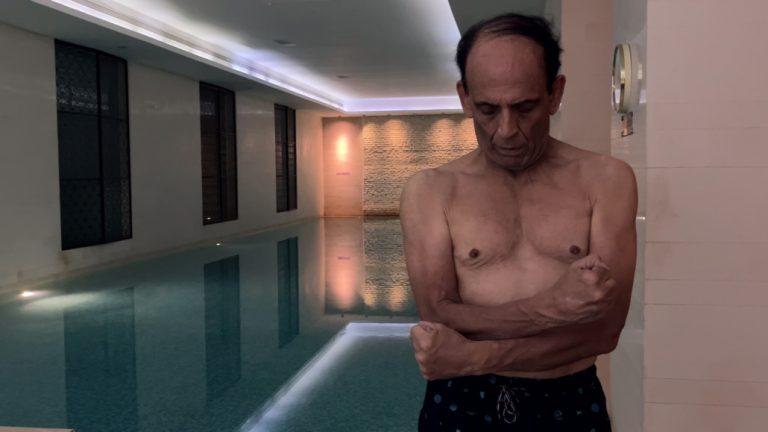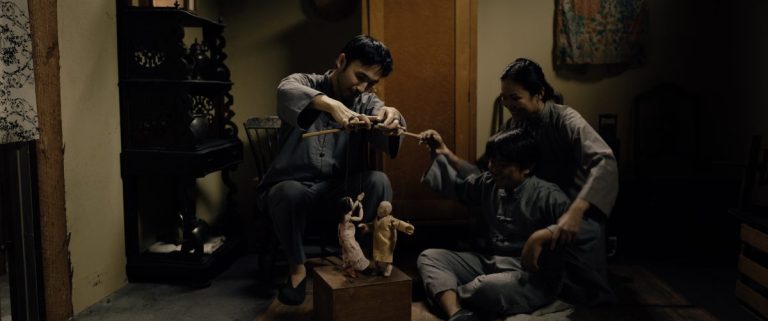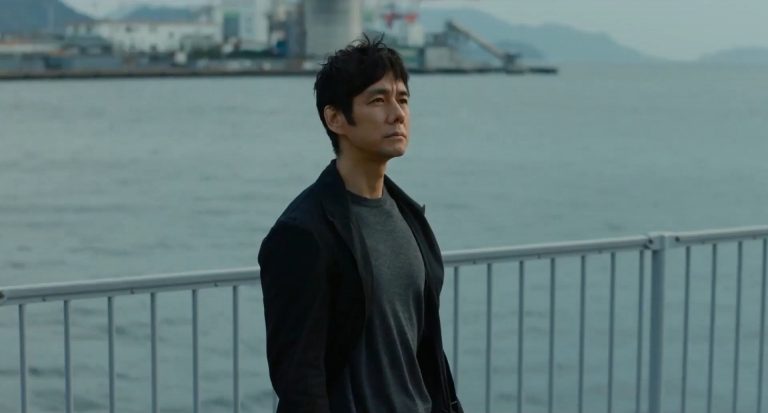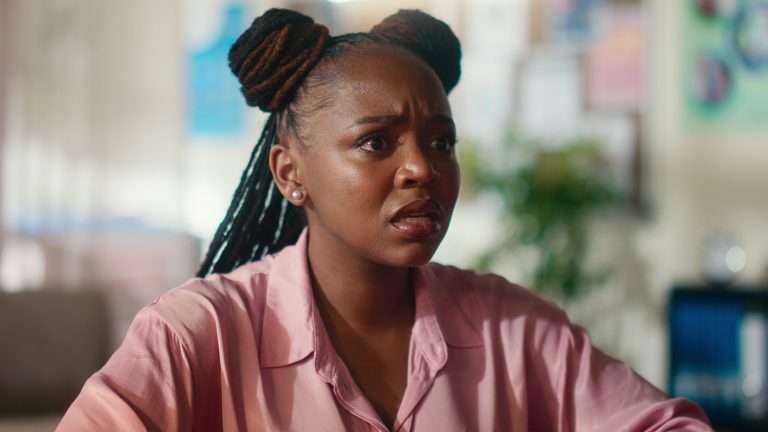Ringu (1998) Movie Ending Explained: Horror films flourished in Japanese cinema of the 1950s and 1960s, although the notion of the horror genre in Japan highly differed from its counterpart in the US. The prominent category in Japanese horror is ‘Kaidan’ (or ghost story), which predominantly features ‘onryou’ (avenging spirit). While American horror, particularly ghost stories, is preoccupied with extinguishing evil spirits and evading the ‘corruption of the human soul,’ Japanese horror regards spirits as something that coexists alongside humans. By the end of a Japanese horror flick, the vengeful spirits often wreak havoc or somehow its threat is evaded, but it still remains at large. Of course, there’s more cultural relevance and narrative depth to the thrills of Japanese horror, which often gets lost in the American remakes.
Recommended: The Others (2001) Horror Movie Ending, Explained
Koji Suzuki’s 1991 novel Ring revisits the ‘onryou’ trope. Interestingly, the invasion of the spirit into the human realm happens through technology – in this case, TV and videotape. Drawing heavily from the religious/cultural traditions of Shintoism, the ‘New Japanese horror’ sets up technology as a conduit for the malevolent spirits to violate and terrorize the human populace. Suzuki’s novel and Hideo Nakata’s brilliant 1998 movie adaptation perfectly blend our age-old phobias of the paranormal and our fears of modern technology. Moreover, Nakata’s Ringu (1998) brought international attention to Japanese horror, leading to the term ‘J-Horror.’
J-Horror is not a film movement but was simply coined by a British distribution company (Tartan Video) for commercial purposes. However, the phenomenal success of Ringu led to the creation of similar psychological horrors firmly rooted in Japanese social and cultural background, including Kiyoshi Kurosawa’s Kairo (2001) and Takashi Shimizu’s Ju-On (2002). With a haunting, unplacatable spirit and a chilling mystery at its center, Ringu (1998) continues to remain an effective horror film. Now, let’s unpack the creepy and enigmatic aspects of Ringu’s narrative.
Spoilers Ahead!
Ringu (1998) Plot Explained:
The Urban Legend of a Cursed Videotape
Ringu opens with two high schoolers, Masami and Tomoko, discussing an urban legend involving a videotape that emerged somewhere in the Izu peninsula. Masami recounts that according to what she heard, the cursed tape will cause its viewers to die in seven days. Immediately after watching the tape, the viewer will also receive an ominous phone call. Tomoko confesses to Masami that she watched a strange videotape with some of her friends while staying in a cabin at Izu. As Masami ponders this, Tomoko mentions it’s one week today. Tomoko, however, breaks the uncomfortable silence and, with a laugh, says she was just kidding.
But the teenagers are interrupted by the phone ringing downstairs. They rush to the phone, and Tomoko is relieved to hear her mother’s voice from the other side. As Masami leaves for the restroom and Tomoko goes to the kitchen, she sees the TV switching on by itself. Tomoko switches off the TV and comes back to the kitchen. She is creeped out by the presence of something, and the frame freezes as she dies with an expression of shock.
What’s the Cause of Tomoko’s Death?
Reiko Asakawa (Nanako Matsushima) is a journalist and divorced single mother investigating this urban legend. While interviewing a student, Reiko hears that a high school student named Yoko Tsuji and her boyfriend, who had seen the videotape, were recently found dead in a parked car. At the workplace, Reiko goes through the newspaper to find the news of two youngsters. Subsequently, she asks her colleague, Okazaki, to inquire about the school’s name. Reiko reaches home to find her little son, Yoichi (Rikiya Otaka), already back from school. They get ready to go to a funeral.
Reiko’s sister Yoshiki’s teenage daughter has passed away. It is none other than Tomoko. At the sister’s home, a woman raises suspicion about the cause of Tomoko’s sudden death. The police have taken the body for autopsy, and the coffin was kept closed. Reiko receives a call from Okazaki, disclosing the school’s name where the dead high school students were studying. Tomoko also went to the same school – Seikei Academy. Therefore, Reiko questions Tomoko’s classmates attending the funeral. They say all three of them – Yoko, her boyfriend, and Tomoko – watched the video and died on the same day. The classmates don’t know where they watched the video.
What’s In the Cursed Videotape?
Reiko goes through the news footage of finding Yoko in the parked car. She learns that the cause of death is unclear. Her heart has simply stopped, and there are no traces of drug usage. Later, Reiko visits her sister, and she finds a receipt from a photoshop in Tomoko’s room. Reiko receives the developed photos showing Tomoko and her friends at Izu. She also sees that in some pictures, the teenagers’ faces look disfigured, particularly the ones taken after the night they watched the videotape.
Reiko travels to Izu to find or inquire about the videotape in the resort where Tomoko stayed. At the hotel lobby, on the videotape shelf, she finds an unlabeled tape and plays it. This is the cursed tape. It contains a series of abstract and subliminal visuals and ends with an eerie shot of a well. After watching the tape, Reiko is stunned to see an apparition in the room. It’s followed by a phone call, full of screeching sounds like the ones she heard in the tape. Reiko notes the time as 7 pm, and it’s September 13th. She leaves the cabin with the tape.
How did Reiko and Ryuji Trace the Origins of the Videotape?
The following day, Reiko calls her ex-husband and university professor, Ryuji Takayama (Hiroyuki Sanada), to help her in her investigation. She asks Ryuji to take her picture in a Polaroid camera. The face in Reiko’s photo looks distorted. Ryuji watches the video and asks her to make a copy for him. Interestingly, Ryuji didn’t receive a phone call.
On 15th September, Reiko tries to trace the tape’s origins by checking the list of customers who recently stayed at the cabin and for pirate broadcasts in Izu. Meanwhile, it’s revealed that Ryuji is a psychic. While sitting in a public space and writing in a notebook, Ryuji senses the presence of Tomoko’s spirit. Reiko arrives at Ryuji’s place and gives him a copy of the tape. They scrutinize each visual composition and find a message (an adage of sorts) embedded within the screeching sounds. Furthermore, the word ‘Eruption’ in the tape catches their attention.
On September 16th, Ryuji calls Reiko at her home. He confirms that the message is a ‘saying’ from the volcanic Oshima island in the Izu archipelago. While further investigating at a library, Reiko finds old news about the eruption of the volcano – Mt. Mihara – in Oshima. The news is also accompanied by a small piece, wondering if a local woman predicted the volcano eruption. Again, Ryuji displays a sense of unease as he feels a spirit’s presence. Ryuji asks Reiko to put him in touch with the Oshima correspondent.
Why did Yoichi Watch the Tape?
On September 17th, Reiko takes Yoichi to visit her father. Yoichi enjoys fishing with his grandfather. Later in the evening, Ryuji calls Reiko. He has found the identity of the woman who predicted the volcano eruption. Her name is Shizuko Yamamura, and she threw herself into the volcano 40 years ago. Shizuko is probably the middle-aged woman in the video – brushing her hair in a mirror. Since Reiko has only three days left, Ryuji suggests going to Oshima island and finding out more about the woman.
At night, Reiko suddenly wakes up to find her son missing in the bed. She is shocked to find Yoichi watching the video. The clip cuts from the shot of the wall to white noise when Reiko finds her son. When a petrified Reiko questions Yoichi why he brought the tape to their grandfather’s home and watched it, the boy says Tomoko urged him to do that. It becomes clear that Yoichi – like his estranged father, Ryuji – can also sense the restless spirits around him.
Who Is Shizuko Yamamura?
On September 18th, during their ferry trip to Oshima island, Ryuji confesses that he did sense something at Reiko’s place. When Reiko says it is Tomoko, Ryuji asserts that it’s not Tomoko anymore. After arriving at the island, Reiko and Ryuji learn that the Yamamura family once ran big fishing crews. They stay at an inn that belongs to Shizuko Yamamura’s cousin, Takashi (Yoichi Numata). When Shizuko predicted the volcano eruption, she was seen as a ‘seer,’ which captured the attention of a professor named Heihachiro Ikuma.

Dr. Ikuma took Shizuko to Tokyo for tests to prove her ESP (Extrasensory perception) abilities. The media spotlight that followed hyped the professor’s experiments on Shizuko and later destroyed them by questioning their credibility. Dr. Ikuma was fired from the university, and Shizuko killed herself. But it’s said that Shizuko had a daughter whose identity and whereabouts are a mystery.
Who’s Shizuko’s Extremely Powerful Psychic Daughter?
On the morning of September 19th, Reiko and Ryuji confront Shizuko’s cousin, Takashi, at the seashore. The grumpy old man is reluctant to talk, but Ryuji, using his psychic abilities, discovers that it was Takashi who called Dr. Ikuma with the intent of making money off Shizuko. When Takashi tries to run away from Ryuji, he accidentally touches his hand, taking him to the exact moment of Shizuko’s demonstration before the media.
During the demonstration, one of the reporters calls Shizuko a ‘fraud.’ The reporter who accuses Shizuko and Dr. Ikuma keels over and suddenly dies. Shizuko sees that it was her daughter, Sadako, who killed the man. She can make someone die by simply thinking about it. Now we see Sadako for the first time – a girl dressed in white and her face covered by long black hair. Later, Ryuji says Sadako’s powers are darker than her mother, Shizuko’s. He also believes Sadako might be dead. The videotape and the curse it carries are Sadako’s rage.
Ringu (1998) Movie Ending Explained:
What Happened To Sadako Yamamura?
Soon, Ryuji and Reiko receive news of an impending typhoon, and ferries are unavailable. Ryuji leaves the inn to find a fisherman who could take them back. In the room, Reiko feels that Sadako’s fate is linked to the cabin where she found the videotape. In fact, only at the cabin a phone call was received after watching the tape. After failing to find a fishing boat, Takashi agrees to take the couple back to the mainland. In the boat, Ryuji thinks Dr. Ikuma might be Sadako’s father, and she might have died before the cabin was built.
The couple reach the cabin on September 20th, the seventh and last day for Reiko. Driven by instinct, Ryuji breaks into the cabin’s crawlspace and finds a closed-in well. As they touch the heavy stone lid of the well, Ryuji and Reiko receive the vision of young Sadako getting hit in the head by Dr. Ikuma and pushed into the well. Since Sadako was alive when she got trapped in the well, the rage she withheld was ‘recorded’ in a videotape, leading to the curse. While draining the water from the well, Reiko finds Sadako’s remains. Subsequently, the deadline for Reiko’s curse passes. They feel finding the remains has appeased Sadako’s spirit. Ryuji also postulates that perhaps Dr. Ikuma killed Sadako because the girl’s real father ‘wasn’t human.’
How Can One Truly Survive from Sadako’s Rage?
Ryuji drops Reiko at home. The following day, Ryuji is busy meeting his project deadline. At some point, he feels unsettled and sees his TV is switched on. The TV shows the image of the abandoned well. While previously, the videotape ended with a visual of the well, now he sees Sadako’s spirit emerging from the well. With the long hair covering her face, the vengeful spirit slowly staggers out of the TV and kills Ryuji.
Reiko reaches Ryuji’s place, and she is haunted by the question of why Ryuji died if they lifted the curse the day before. She also wonders if her son, Yoichi, will die. Back at her home, Reiko sees Ryuji’s apparition hinting at how to survive Sadako’s curse, i.e., copying the tape and making someone watch it. Therefore, it becomes clear that finding Sadako’s remains didn’t lift the curse for Reiko. She accidentally copied the videotape and evaded the curse.
Reiko decides to save Yoichi by driving to her father’s place and showing the tape to him. Hence, the film’s title, Ringu (Ring), can be interpreted as the never-ending cycle of the curse. An individual can prevent their death from the curse only by spreading it like a virus.
Ringu (1998) Themes Explained:
Motherhood
Screenwriter Hiroshi Takahashi and director Hideo Nakata changed the central character’s gender – from male to female – for the movie adaptation. This leads to an intriguing exploration of single motherhood. It’s not just the independent and working woman, Reiko, who struggles to juggle between her job and taking care of her child; Shizuko – Sadako’s mother – also finds it hard to fulfill the demands of single motherhood. Through Reiko’s journey to find the enraged spirit’s identity, we comprehend the family dynamics between Reiko, Yoichi, and Ryuji. While Ryuji isn’t an extreme personality like Dr. Ikuko, the father figures in the narrative are absent and totally neglect their duties.
Ringu also hints that the broken family or non-nuclear family unit facilitates the restless, avenging spirit to insinuate itself among them gradually. The 2002 J-horror Dark Water, directed by Hideo Nakata (again based on a Koji Suzuki novel), also shares the theme of single motherhood, where the mother tries to save her girl child from a hostile entity.
Technology
Technology is often linked with social transformations and the anxieties or fears accompanying such changes. Sadako coming to life through a television screen seems like a fascinating metaphor for ‘harmful content.’ Spreading the tape like a virus is shown as the only cure from the technologically inscribed curse. From a contemporary context, the act of making more people consume the content to evade the curse feels like an allegory about the spread of technology among the masses. In fact, technology metastasizing in society and feeding on people’s lives is a pivotal theme in Kiyoshi Kurosawa’s Kairo or Pulse (2001). While the spirit in Ringu projects itself through the now outdated technology of VHS tapes, in Kairo, the internet becomes the passageway for malevolent ghosts.
Shinto
In Western culture, an evil spirit or a demon is often perceived as a part of Satan or the Devil’s devious plans. Purging such entities from the human body and retaining one’s soul is viewed as a victory for God’s side. Unlike the dualities found in Abrahamic religions, Shinto is polytheistic – a combination of Japanese folk beliefs. Shintoism’s reference to ‘Kami’ – gods or spirits – is a more complex concept that embraces all things that withhold the essence of existence. Hence, Kami is not always good or perfect. Most Shinto rituals try to pacify, leave offerings, or keep away the kami that are recognized as evil or angry.
In Ringu, we encounter a vengeful spirit (Onryo – often wronged women), a recurrent and old trope in Japanese Kwaidan (ghost story). And we learn that this particular spirit can’t be quelled by acknowledging the injustice or by showing compassion (as seen in Reiko’s motherly gesture in the well). Hence, an onryo is profoundly terrifying due to her insatiable rage.









